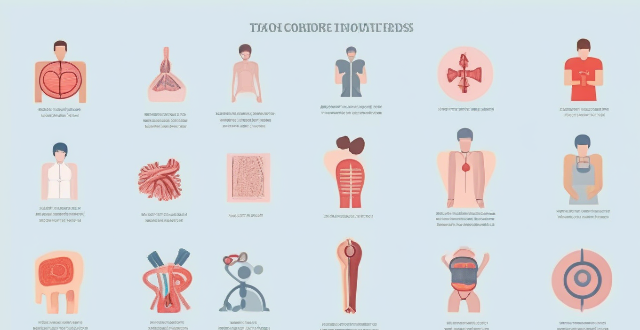Sports Risk

How does participating in extreme sports affect mental toughness and risk-taking behavior ?
Extreme sports can positively affect mental toughness and risk-taking behavior, helping individuals build resilience and manage risks effectively. However, it is crucial to prioritize safety and recognize personal limitations.

Is there a correlation between playing sports and reduced risk of obesity in adolescents ?
The text discusses the correlation between playing sports and reduced risk of obesity in adolescents. It defines obesity as an excessive accumulation of fat that poses a risk to health and is typically assessed using body mass index (BMI). The importance of physical activity, particularly sports participation, in preventing obesity during adolescence is highlighted. Numerous studies have found a positive correlation between sports participation and reduced obesity risk, with mechanisms including increased energy expenditure, muscle development, improved dietary habits, and psychosocial benefits. However, potential limitations such as selection bias, cultural variations, and gender differences should be considered. Encouraging sports participation among adolescents could be an effective strategy for combating obesity, but it should be part of a broader approach that includes education on nutrition and other forms of physical activity.

Is there a risk that AI could replace human referees or umpires in sports ?
The article discusses the potential risks and benefits of using Artificial Intelligence (AI) in sports officiating. The benefits include improved accuracy, increased efficiency, and consistency across games. However, there are also risks such as lack of human judgment, cost and accessibility, and potential for bias. It is important to address these risks and ensure that AI systems complement rather than replace human referees or umpires.

How much does sports insurance cost ?
The cost of sports insurance varies based on the type of sport, level of coverage, and individual's age and health status. High-risk sports typically have higher premiums than lower-risk activities. Basic policies may only cover medical expenses and lost wages due to injury, while more comprehensive plans may include additional benefits such as disability coverage and accidental death and dismemberment insurance. Younger athletes may have lower premiums than older ones, and individuals with pre-existing medical conditions or a history of injuries may face higher premiums. Tips for finding the best sports insurance policy include shopping around, considering bundling, and asking about discounts.

What are the benefits of participating in sports to reduce the risk of video game addiction ?
Participating in sports can have numerous benefits for individuals who are at risk of developing a video game addiction. These include increased physical activity, social interaction, time management, mental health benefits, and the development of life skills. By engaging in sports, individuals can find a healthy balance between gaming and other activities, leading to a more fulfilling and well-rounded lifestyle.

Can studying sports biomechanics help prevent injuries in athletes ?
Sports biomechanics can help prevent injuries in athletes by identifying risk factors, optimizing movement patterns, and providing feedback and guidance. Examples include analyzing baseball pitchers' mechanics to reduce strain on their joints, gymnasts' movements to identify areas of stress, and runners' form to improve efficiency and reduce strain on their knees and ankles. By working with coaches and trainers who specialize in sports biomechanics, athletes can improve their technique and reduce their risk of injury over time.

Are there any particular sports or activities recommended for people at high risk of chronic diseases ?
The text provides recommendations for sports and activities suitable for individuals at high risk of chronic diseases such as heart disease, diabetes, or obesity. It emphasizes the importance of regular physical activity and suggests low-impact cardiovascular exercises like walking, swimming, and cycling. Strength training options include resistance band workouts, bodyweight exercises, and light weightlifting. The text also highlights flexibility and balance exercises like yoga and Tai Chi. It advises starting slowly, using proper equipment, and consulting professionals to ensure safety and effectiveness.

What are the potential risks associated with sports sponsorship and how can they be mitigated ?
Sports sponsorship is a popular marketing strategy used by companies to promote their brand, products, or services. However, there are potential risks associated with sports sponsorship that need to be considered and mitigated. These risks include reputational risk, financial risk, and legal risk. To mitigate these risks, companies should conduct thorough research on the athlete/team before signing a sponsorship deal, ensure alignment between the sponsor's values and those of the sponsored entity, set clear budgets for sponsorship activities, monitor the performance of the sponsored entity, negotiate flexible contract terms, and work with legal experts to ensure compliance with all relevant laws and regulations. By managing these risks, companies can maximize the benefits of their sports sponsorship investments.

How does a warm-up affect performance in sports ?
Warming up before sports activities is crucial for enhancing performance and preventing injuries. A proper warm-up increases blood flow to the muscles, reduces injury risk, improves coordination and reaction time, and provides mental preparation. There are different types of warm-ups, including general warm-up, specific warm-up, and dynamic stretching. Incorporating these warm-up activities can optimize an athlete's performance and minimize the risk of injuries during competition.

What are the potential risks and challenges associated with the increasing reliance on technology in sports ?
The integration of technology in sports has revolutionized the way games are played, watched, and analyzed. However, this increasing reliance on technology also brings several potential risks and challenges that need to be addressed, including overreliance on technology, cheating and unfair advantages, data privacy and security concerns, cost and accessibility issues, and health concerns related to excessive use of certain technologies. Addressing these challenges is crucial for maintaining the integrity and fairness of sports while still enjoying the benefits of technological advancements.

Are there any health concerns associated with prolonged use of sports tracking devices ?
Sports tracking devices have become increasingly popular in recent years, as they allow individuals to monitor their physical activity and fitness levels. However, there are potential health concerns associated with the prolonged use of these devices. One major concern is the excessive reliance on data provided by sports tracking devices. While it is helpful to track your progress and set goals, relying solely on the numbers can lead to a disconnect between how you feel physically and what the device is telling you. This can result in overtraining or pushing yourself too hard, which can cause injuries or burnout. Another issue is the neglect of other aspects of fitness that cannot be measured by sports tracking devices. For example, flexibility, balance, and coordination are important components of overall fitness but are often overlooked when focusing solely on metrics like steps taken or calories burned. This can lead to imbalances in your fitness routine and potentially increase your risk of injury. Prolonged use of sports tracking devices can also cause skin irritation or allergies due to the materials used in the device's construction. Some people may be sensitive to certain metals, plastics, or adhesives used in the device, which can cause redness, itching, or swelling at the site of contact. Additionally, wearing a sports tracking device constantly can create a warm, moist environment on your skin that is ideal for bacterial growth. This can increase your risk of developing infections such as cellulitis or folliculitis, especially if you do not clean the device regularly or give your skin a chance to breathe by removing the device occasionally. Many sports tracking devices also have sleep tracking functionality, which can be helpful for monitoring your sleep patterns and identifying areas for improvement. However, relying too heavily on this feature can disrupt your natural sleep cycle and contribute to poor sleep quality. The constant monitoring and analysis of your sleep data can create anxiety around getting enough rest, leading to increased stress levels and further sleep disturbances. Another issue related to sleep disruption is the blue light emission from many sports tracking devices. Blue light has been shown to suppress melatonin production, a hormone responsible for regulating sleep-wake cycles. Exposure to blue light before bedtime can make it more difficult to fall asleep and stay asleep throughout the night. To mitigate these risks, it is recommended to: - Balance Data with Self-Awareness: Use the data provided by sports tracking devices as a guide rather than a definitive measure of your fitness level. Pay attention to how your body feels during exercise and listen to any signs of fatigue or discomfort. - Incorporate Variety into Your Fitness Routine: Include activities that focus on flexibility, balance, and coordination in addition to those that can be tracked by sports tracking devices. This will help ensure a well-rounded fitness routine and reduce the risk of injury. - Maintain Proper Hygiene: Clean your sports tracking device regularly according to the manufacturer's instructions and give your skin a chance to breathe by removing the device occasionally. This will help prevent skin irritation and reduce the risk of infection. - Limit Sleep Tracking and Blue Light Exposure: Be mindful of how much you rely on sleep tracking features and avoid using devices that emit blue light before bedtime. This will help maintain healthy sleep patterns and promote overall well-being.

Are there any risks associated with the treatments offered at sports rehabilitation centers ?
Sports rehabilitation centers offer a range of treatments aimed at helping athletes recover from injuries and improve performance, but there are potential risks associated with these therapies. Incorrect diagnosis or misdiagnosis, overexertion or reinjury, adverse reactions to treatments, infection risks, and long-term effects of treatments are some of the common risks associated with sports rehabilitation treatments. Athletes should work closely with their therapists to ensure proper diagnosis and treatment planning while being aware of potential risks and seeking prompt medical attention if needed.

Can taking sports nutrition supplements lead to health risks or side effects ?
Sports nutrition supplements can enhance performance and recovery but may pose health risks and side effects such as overdosing, contamination, interactions with medication, and allergic reactions. However, when used appropriately, they can also improve performance, increase muscle mass, aid in recovery, and replenish nutrients. It is crucial to research each supplement, follow recommended dosages, and consult with a healthcare professional to minimize risks and maximize benefits.

What are the risks associated with overtraining in a sports program ?
Overtraining, or "overreaching," is a condition that arises when an athlete consistently trains beyond their body's capacity to recover. This can lead to various physical and psychological risks, including musculoskeletal injuries, immune system suppression, hormonal imbalances, decreased performance, cardiovascular stress, sleep disturbances, nutritional deficiencies, burnout syndrome, mood disorders, reduced motivation, and cognitive impairment. To prevent and manage these risks, athletes, coaches, and sports medicine professionals should implement regular recovery periods, ensure adequate nutrition and hydration, monitor training load, prioritize sleep quality and quantity, and seek professional help if signs of overtraining persist. It is crucial to be aware of the potential risks associated with overtraining to ensure long-term health and well-being in a sports program.

What is the risk involved in investing in bonds ?
Investing in bonds carries risks such as interest rate, credit, inflation, liquidity, reinvestment, call, prepayment, foreign currency, and political/regulatory changes. Understanding and managing these risks is crucial for protecting your investment. Diversifying your portfolio across different types of bonds and monitoring market conditions can help mitigate these risks.

How does sports medicine help prevent injuries in sports ?
The text discusses how sports medicine helps in preventing injuries in sports by providing athletes with necessary knowledge, skills, and resources for maintaining their health and safety. It outlines key ways such as pre-participation physical examinations, proper warm-ups, strength training programs, correct technique, injury management, and education. These measures aim to identify risks, prepare the body for exercise, enhance fitness levels, promote safe practices, and manage injuries effectively. Overall, sports medicine plays a vital role in fostering a culture of safety and well-being within sports communities.

Is there a link between sleep duration and sports injuries ?
This article explores the relationship between sleep duration and sports injuries, highlighting the importance of adequate sleep for athletes. Studies have found that both short and long sleep durations can increase the risk of injury, emphasizing the need for a balanced approach to sleep. Athletes are advised to establish consistent sleep habits, aim for 7-9 hours of sleep per night, and monitor their sleep patterns to minimize the risk of sports injuries and enhance performance.

How can I prevent sports injuries ?
Sports injuries can be prevented by following these five key tips: warming up and stretching before physical activity, wearing proper gear, using proper technique, staying hydrated and nourished, and taking breaks and rest days. By implementing these measures, athletes can reduce their risk of injury and stay safe while playing sports.

What are the key components of a successful disaster risk management plan ?
Key Components of a Successful Disaster Risk Management Plan include: 1. Risk Assessment 2. Prevention and Mitigation Strategies 3. Preparedness Activities 4. Response Mechanisms 5. Recovery and Rehabilitation 6. Continuous Improvement

Can I get sports insurance for my child who plays school sports ?
Sports insurance can provide coverage for athletes participating in organized sports, including school sports. Consider factors like age limit, type of sports, level of competition, and coverage details when selecting a policy. Cost, duration, additional benefits, and the application process are also important considerations. While sports insurance offers peace of mind and financial protection, it can be expensive and may have limitations. Evaluate your child's needs and consult with an insurance professional to make an informed decision.

Why is it important to conduct a climate risk assessment ?
Climate risk assessment is crucial for understanding the potential impacts of climate change on different sectors and systems, identifying vulnerabilities and risks, developing adaptation strategies and policies, enhancing resilience and reducing losses, and supporting decision making. It helps in building a more resilient and sustainable future for all.

How does sports insurance work ?
Sports insurance is a specialized form of insurance that protects athletes and sports participants from financial losses due to injuries or accidents that may occur during physical activities. It provides coverage for medical expenses, lost wages, and other related costs associated with sports-related injuries. There are several types of sports insurance policies available, including personal accident insurance, liability insurance, equipment insurance, and travel insurance. Sports insurance typically covers a wide range of sports-related injuries and accidents, including medical expenses, disability, funeral costs, legal fees, equipment damage or theft, and travel expenses. The cost of sports insurance varies depending on several factors, including the type of sport, the level of risk involved, the policyholder's age and health status, and the amount of coverage desired.

In what ways does exercise improve mental health, potentially reducing the risk of chronic diseases ?
Regular exercise has been found to have numerous mental health benefits, such as boosting mood and reducing stress, improving sleep quality, enhancing cognitive function, promoting social interaction, and boosting self-esteem and body image. Additionally, regular physical activity can potentially reduce the risk of chronic diseases like cardiovascular diseases, diabetes, and obesity. Incorporating exercise into your daily routine can improve both physical and mental well-being.

Is there a link between exercise and reduced risk of depression ?
**Link Between Exercise and Reduced Risk of Depression: A Comprehensive Overview** Depression is a prevalent mental disorder that affects millions globally. While its exact cause remains unclear, various factors, including lifestyle choices like exercise, have been studied for their potential to reduce the risk. This article delves into the evidence supporting the link between exercise and reduced risk of depression, exploring studies on animals and humans, potential mechanisms underlying this relationship, and practical tips for incorporating exercise into one's routine. **Studies on Animals:** Research has shown that regular exercise in rats can increase BDNF levels, a protein linked to the development and treatment of depression. This suggests that exercise may help reduce depression risk by boosting BDNF levels. **Studies on Humans:** Numerous studies have investigated the human connection between exercise and depression. A meta-analysis found exercise significantly reduces depressive symptoms compared to no treatment or placebo interventions. Another longitudinal study showed that regular physical activity lowers the likelihood of developing depression compared to sedentary behavior. **Potential Mechanisms:** Several mechanisms could explain how exercise reduces depression risk: * **Neurobiological Changes:** Exercise increases BDNF levels, promoting neuronal growth and improving mood. It also alters neurotransmitter levels involved in mood regulation. * **Endocrine Response:** Exercise stimulates endorphin release, producing pleasure and reducing pain perception, contributing to improved mood. * **Psychosocial Benefits:** Regular physical activity provides social interaction opportunities, enhancing mental health. It also improves self-esteem and body image. * **Stress Reduction:** Exercise reduces stress by decreasing cortisol secretion and promoting relaxation, which helps prevent depression since stress is a known risk factor. **Practical Tips:** To reduce your depression risk through exercise, start slowly with low-intensity activities, find enjoyable exercises, set realistic goals, make it social, and monitor your progress. In conclusion, ample evidence supports a link between exercise and reduced risk of depression. Both animal and human studies demonstrate the mood-enhancing effects of regular physical activity. By understanding the potential mechanisms and incorporating exercise into your routine, you can potentially lower your risk of developing depression and improve your overall well-being.

How does technology help in preventing and managing sports injuries ?
Technology plays a crucial role in preventing and managing sports injuries through wearable devices, advanced imaging techniques, rehabilitation technologies, and preventive measures such as biomechanical analysis and nutrition tracking. These tools help athletes maintain optimal health and minimize their risk of injuries.

How can governments implement climate risk management policies to protect their citizens and infrastructure ?
Governments can implement climate risk management policies by assessing the risks, developing a comprehensive plan, investing in resilience and adaptation measures, engaging stakeholders and building public awareness, and monitoring and evaluating progress.

What is disaster risk management ?
Disaster risk management (DRM) is a comprehensive approach aimed at reducing the impact of natural and human-made disasters on communities. It involves understanding, assessing, and reducing risks through prevention, preparedness, response, and recovery strategies. The goal is to ensure that people's lives and livelihoods are not compromised by disaster events. Key components include risk assessment, hazard mitigation, early warning systems, emergency planning, community education, immediate action, coordination, rehabilitation, reconstruction, and sustainable development. Best practices involve multi-stakeholder collaboration, gender sensitivity, use of technology, inclusive planning, and regular review and updating. Challenges include limited resources, political will, information gaps, and cultural differences. Effective DRM requires a multifaceted approach that considers social, economic, and environmental factors.

What is climate risk assessment ?
Climate risk assessment is a systematic process that identifies, evaluates, and prioritizes the potential impacts of climate change on a specific region or sector. It involves analyzing the likelihood and severity of various climate-related risks, such as extreme weather events, sea level rise, and changes in temperature and precipitation patterns. The goal of climate risk assessment is to inform decision-makers about the risks associated with climate change and help them develop strategies to manage and adapt to these risks. Key components of climate risk assessment include identifying potential risks, evaluating their potential impacts, prioritizing them based on severity and likelihood of occurrence, and developing adaptation strategies to reduce potential impacts. By implementing these strategies, decision-makers can help ensure that their communities are better prepared for the challenges posed by climate change.

Is sports insurance necessary for amateur athletes ?
This article explores the necessity of sports insurance for amateur athletes. It defines sports insurance as coverage against injuries sustained during sports activities, including medical expenses, lost income, rehabilitation costs, equipment damage, and liability coverage. The article highlights the risks and costs associated with sports injuries, noting that 62% occur during recreational activities rather than competitive events. It argues that sports insurance offers peace of mind, financial protection, and access to quality care for amateur athletes but may not be necessary for all. Factors to consider when deciding whether to purchase sports insurance include risk level, personal finances, existing health insurance, and frequency of participation.

Is there a link between sedentary lifestyle and increased risk of mental health disorders ?
This article explores the link between sedentary lifestyle and increased risk of mental health disorders such as depression, anxiety, and stress-related disorders. It suggests that lack of exercise can contribute to these issues due to decreased endorphin release and higher cortisol levels. The article recommends increasing physical activity, taking frequent breaks from sitting, and practicing mindfulness and stress-reduction techniques to reduce these risks.